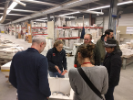Making Bibelot: Casting material research within cultural frameworks
Material investigations in architecture often exclude practice implications by narrowly determining the scope and limitations of research. Such limitations are necessary and warranted for open-ended inquiries undertaken in controlled conditions. Working with commercial outfits in the context of a prescribed project, on the other hand, requires a clear attitude that accounts for the agency of the manufacturer. A small design-build intervention, completed with an in-kind donation from a terra cotta manufacturer in Buffalo, New York, gave the opportunity to take on a collaborative investigation.
In order to explore the potentials of terra cotta as a building material to the greatest extent, the team strategically increased the complexity of the endeavor, challenging the design and manufacturing team to address production problems in a timely manner to meet the project goals. In doing so, they relied on conceptual constructs that address specific material and institutional histories of terra cotta and the cultural context, registered as form, color, and ornamentation in the project.
In the age of ubiquitous digital media, faculty mailboxes remain one of the most central features of academic settings, characterized by slow change and persistence of institutional memory. As such, the project has provided an opening for the design team to delve into notions of communicability and referentiality and explore the ability of complex material constructs to operate on a plane of institutional culture and memory. The medium of terra cotta further enhances this framework. As others have observed, the ability of terra cotta to register the imprints of manufacturing processes and bridge crafts and industrial applications renders it uniquely rich, inviting the designer to engage with the embedded histories of the material (Charles, 2018). Embracing the multiplicity of histories has helped to expand the scope of the project laterally, while the specific condition of the competition and time constraints introduced certain limitations.
Author
Erkin Özay, Gregory Delaney, Nicholas Traverse and Andrew Pries (Boston Valley Terra Cotta)
Journal
Frontiers of Architectural Research, vol. 8, issue 2
Date Published
June 2019






